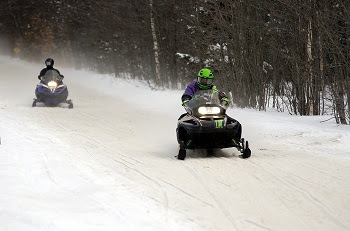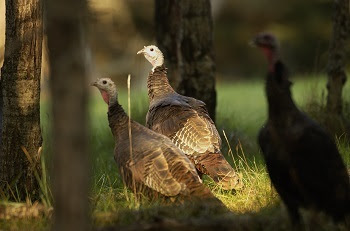| Here are just a few of this week’s stories from the Michigan Department of Natural Resources:
See other news releases, Showcasing the DNR stories, photos and other resources at Michigan.gov/DNRPressRoom.
PHOTO FOLDER: Larger, higher-res versions of many of the images used in this email are available in this folder.
 See any fields full of tree tubes during your travels? Those sleeves are protecting little trees that will become the next generation of state forests. Although at this time of year our leafy trees are bare and heading into their winter sleep, we’re looking ahead to spring, thanks to the efforts of DNR foresters and donors. See any fields full of tree tubes during your travels? Those sleeves are protecting little trees that will become the next generation of state forests. Although at this time of year our leafy trees are bare and heading into their winter sleep, we’re looking ahead to spring, thanks to the efforts of DNR foresters and donors.
This year, we planted 5.6 million trees in state forests, plus another 820,000 in national forests through the Good Neighbor Authority partnership with the U.S. Department of Agriculture’s Forest Service.
Donors from the Arbor Day Foundation, American Forests, Finkl & Sons and One Tree Planted contributed to the effort, providing more than $1.4 million to add more trees to Michigan’s landscape. Funds helped purchase seedlings and planting equipment such as tree tubes to protect young trees from hungry herbivores like deer.
Tree species planted include jack pine, red pine, northern red oak and white pine.
These new trees will produce an array of benefits. Renewable forest products, outdoor places to hunt, hike and explore, and habitat for wildlife including the rare Kirtland’s warbler and game species such as grouse and elk are all provided by Michigan’s sustainably managed forests.
Tree planting isn’t the only way the DNR renews forests. While seedlings are planted to regrow some areas following timber harvest or insect damage, natural regeneration also is encouraged. Heavy machinery is used to rough up the soil and allow seeds from nearby trees to take root. Soon, what was once a bare field is full of young saplings stretching toward the sun.
Questions about tree planting on state-managed lands? Visit Michigan.gov/MiTrees to view our statewide planting map and add your own new trees, or contact DNR silviculture expert Jason Hartman. |
 If you’re thinking about suiting up and sledding Michigan’s thousands of miles of state-designated trails, it’s time to pull your sled out of storage, prep it for winter and purchase your 2023-24 snowmobile trail permit. The snowmobile program is 100% funded with trail permit dollars. If you’re thinking about suiting up and sledding Michigan’s thousands of miles of state-designated trails, it’s time to pull your sled out of storage, prep it for winter and purchase your 2023-24 snowmobile trail permit. The snowmobile program is 100% funded with trail permit dollars.
Get ready! State-designated trails are open Dec. 1 through March 31, and grooming occurs when there is enough snow on the ground. Learn more and purchase your trail permit today. |
 Whether you live on a lake, enjoy a secret fishing spot or escape the daily grind at a serene lake in the woods, you already know that lakes provide big benefits to mental and physical health and deserve our appreciation and attention. You can discover even more connections through an upcoming Michigan State University Extension opportunity. Whether you live on a lake, enjoy a secret fishing spot or escape the daily grind at a serene lake in the woods, you already know that lakes provide big benefits to mental and physical health and deserve our appreciation and attention. You can discover even more connections through an upcoming Michigan State University Extension opportunity.
A nationally recognized, award-winning, six-week class for anyone with a passion or curiosity for inland lakes, including lakefront property owners, local government officials, lake managers and educators, MSU Extension’s Introduction to Lakes Online course is full of information and inspiration. Led by Extension educators and state agency personnel, it covers lake ecology, watersheds, shorelines, water law, aquatic plant management and community involvement.
Registration, course information
The course runs Jan. 30 through March 20. Register by Jan. 12 for the early-bird discounted rate of $95 per person; after that, the rate is $115. Registration closes Jan. 28. Course details and scholarship and other information are available on the Introduction to Lakes Online course webpage.
More than 1,850 people across the country have taken the annual course since it was first offered online in 2015. Participants regularly praise the content and level of interaction they enjoy with instructors and other students. |
Students will experience:
- Week-by-week, 24/7 access to six online units, complete with prerecorded video lectures, interactive activities, other resources and quizzes.
- Lively discussion forums and biweekly webinars with classmates and instructors. Ask-an-expert webinars let you learn from experts at the DNR, MSU and the Michigan Department of Environment, Great Lakes, and Energy.
Upon finishing the course, students receive a certificate of completion. They also can receive continuing education credits, including 16 Michigan Department of Agriculture and Rural Development Pesticide Applicator Re-Certification credits and educational hours in the MSU Extension Master Gardener, Master Citizen Planner and Master Naturalist programs.
Questions? Contact Paige Filice (MSU Extension), 517-676-7291 or Joe Nohner (DNR), 517-599-6825.
 If last year’s results (the first year of mandatory online reporting of deer harvests) are any indication, the DNR is hopeful to see 2023 reporting that goes just as well. If last year’s results (the first year of mandatory online reporting of deer harvests) are any indication, the DNR is hopeful to see 2023 reporting that goes just as well.
Online reporting provides the most efficient and effective data for deer management and conservation, and it’s pretty easy, too. More than 208,000 hunters submitted online harvest reports in 2022, with nearly 83% of those hunters able to complete their report in under five minutes.
Earlier this month, we shared a news release outlining steps for smooth, simplified reporting, including three key points: 1) Download the Michigan DNR Hunt Fish app, 2) Have your hunting license/kill tag number ready, and 3) Wait for the confirmation number to pop up and then record it for your records. Read the full story for detailed reporting and assistance information.
Questions? Contact Dustin Isenhoff at 517-275-1468 or the DNR Wildlife Division at 517-284-9453. |
 Wild turkeys can be found across Michigan roosting in trees (really!) and strutting and puffing out their feathers. But that wasn’t always the case. By the turn of the 20th century, wild turkey populations across the state were decimated due to the destruction of critical habitat and unregulated hunting. Wild turkeys can be found across Michigan roosting in trees (really!) and strutting and puffing out their feathers. But that wasn’t always the case. By the turn of the 20th century, wild turkey populations across the state were decimated due to the destruction of critical habitat and unregulated hunting.
Did you know that turkeys not only gobble, they also cluck and purr? In addition to flying, wild turkeys can even swim when needed! Thanks to collaborative conservation, these incredible birds are once again thriving across Michigan’s forests and open woodland habitats.
In the 1950s, the Michigan DNR began an effort with partners to reintroduce wild turkeys to the state. Fifty wild turkeys were purchased from Pennsylvania and released into the open woodlands of Allegan County, helping to strengthen and diversify the population. Thirty years later, wild turkeys from Missouri and Iowa were released across the state. There are now 200,000 wild turkeys gobbling across Michigan thanks to a half-century of partnership. |
 “Conservation success stories like the reintroduction of wild turkeys in Michigan are examples of what is possible through years of strong partnerships and community support,” said Adam Bump, DNR upland game bird specialist. “We work closely with conservation organizations like the National Wild Turkey Federation and their local chapters to restore and enhance habitat that wild turkeys need to thrive.” “Conservation success stories like the reintroduction of wild turkeys in Michigan are examples of what is possible through years of strong partnerships and community support,” said Adam Bump, DNR upland game bird specialist. “We work closely with conservation organizations like the National Wild Turkey Federation and their local chapters to restore and enhance habitat that wild turkeys need to thrive.”
NWTF is a MI Birds partner and has co-hosted immersive birding field trips at oak-savannah restoration sites, engaging the birding community in wild turkey conservation. Some songbird favorites like eastern towhees and blue-winged warblers rely on the same habitat to thrive.
Read the full MI Birds story to learn how you can help support Michigan’s wild turkey populations.
MI Birds is a public outreach and engagement program presented by Audubon Great Lakes and the Michigan DNR that works to build and bring together wildlife enthusiasts across the state to engage with and conserve Michigan’s birds, wildlife and public lands.
Questions? Contact the DNR Wildlife Division at 517-284-9453. |
 See more pictures by Michigan state parks photo ambassadors at Instagram.com/MiStateParks. For more on the program, call Stephanie Yancer at 989-274-6182. (This photo is by Greg Viau, for the Michigan DNR, at Hoffmaster State Park in Muskegon County.) See more pictures by Michigan state parks photo ambassadors at Instagram.com/MiStateParks. For more on the program, call Stephanie Yancer at 989-274-6182. (This photo is by Greg Viau, for the Michigan DNR, at Hoffmaster State Park in Muskegon County.)
|